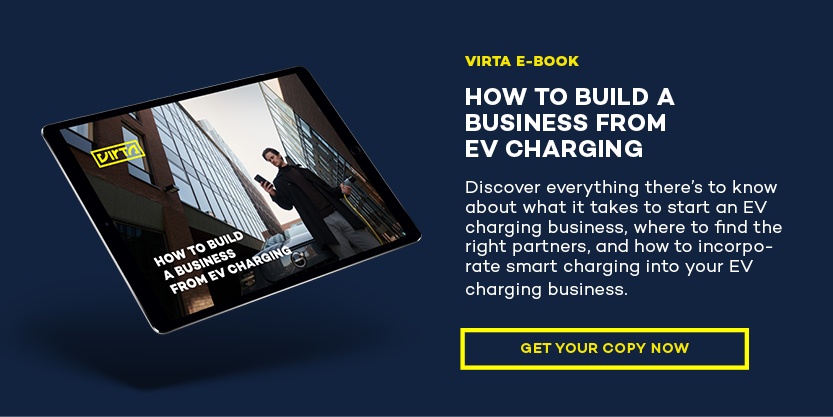Vehicle-to-Grid (V2G)
EVERYTHING YOU NEED TO KNOW ABOUT V2G
Introduction
Vehicle-to-grid (V2G) is a technology with the power to transform the energy system. Let's learn more!
In the fight against global warming, renewable energy sources have a significant role to play. But their volatility causes instability in our energy system and requires significant energy storage capacity. With vehicle-to-grid (V2G) technology, we can use electric vehicles to manage renewable energy demand better and balance our energy system.
What is Vehicle-to-Grid?
Vehicle-to-grid, or V2G for short, is a technology that enables energy to be pushed back to the power grid from the battery of an electric vehicle (EV). With V2G technology, an EV battery can be discharged based on different signals – such as energy production or consumption nearby.
V2G technology powers bi-directional charging, which makes it possible to charge the EV battery and take the energy stored in the car’s battery and push it back to the power grid. While bi-directional charging and V2G are often used synonymously, there is a slight difference between the two.
While bi-directional charging means two-way charging (charging and discharging), V2G technology only enables the flow of the energy from the car’s battery back to the grid.
How about V2X?
Besides V2G, there is another abbreviation often mentioned in relation to bi-directional charging - V2X. V2X means vehicle-to-everything. It includes many different use cases, such as vehicle-to-home (V2H), vehicle-to-building (V2B) and vehicle-to-load (V2L) services.
Depending on whether you want to use electricity from an EV battery in your home or an office building, there are different abbreviations for each of these use cases. Your EVs can work for you, even when feeding back to the grid isn’t the case for you.
In a nutshell, the idea behind V2G is similar to regular smart charging. Smart charging, also known as V1G charging, enables us to control the charging of EVs in a way that allows the charging power to be increased and decreased when needed.
Vehicle-to-grid goes one step further and enables the charged power also to be momentarily pushed back to the grid from car batteries to balance variations in energy production and consumption.
Read also:
Why should you care about V2G?
Long story short, V2G helps mitigate climate change by allowing our energy system to balance more and more renewable energy. However, to succeed in tackling the climate crisis, three things need to happen in the energy and mobility sectors: Decarbonisation, energy efficiency, and electrification.
In the context of energy production, decarbonisation refers to the deployment of renewable energy sources, such as wind and solar. This introduces the problem of energy storage. While fossil fuels can be seen as a form of energy storage as they release energy when burned, wind and solar power function differently.
This energy should be either used when it’s produced or then stored for later usage. As renewable energy production increasingly makes its way into our energy system, it creates more volatility and a need for new ways of balancing and storing renewable energy.
Simultaneously, the transportation sector is doing its fair share of carbon reduction. A notable proof of that is the number of EVs on our roads, which is steadily increasing. In 2022, 14% of all cars sold were electric, while that number was only 5% in 2020.
EV batteries are by far the most cost-efficient form of energy storage since they require no additional investments in hardware. With V2G, we can utilise the battery capacity up to 10x more efficiently than with regular smart charging. Vehicle-to-grid technology enables us to make the best use of the existing population of vehicles.
And by 2030, there could be up to 250 million EVs globally. That means that we’ll have around 250 million tiny energy storages on wheels. Research actually shows that by the end of this decade, EV batteries should be able to meet the demand for short-term energy storage.
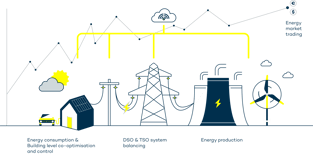
Virta's vision for V2G solutions
Stationary energy storages — big power banks in a sense — are becoming more common. They are a handy way of storing energy from, for instance, large solar power plants. According to predictions, 6% of global electricity production could be stored in batteries within the upcoming 20 years.
For example, Tesla and Nissan offer home batteries for consumers. These home batteries, together with solar panels and home EV charging stations, are a great way to balance out energy production and consumption in detached houses or small communities.
Pump stations are another common form of energy storage. Water is continuously pumped up and down to produce and store the produced energy.
On a larger scale, and compared to electric vehicles aka batteries on wheels, these energy storages are more expensive to supply and require significant investments. As the number of EVs is continuously rising, electric cars provide a much better option with no extra costs.
At Virta, we believe that electric cars are simply the smartest way to help with renewable energy management and production, as EVs will be part of our lives in the future — regardless of the ways we choose to use them.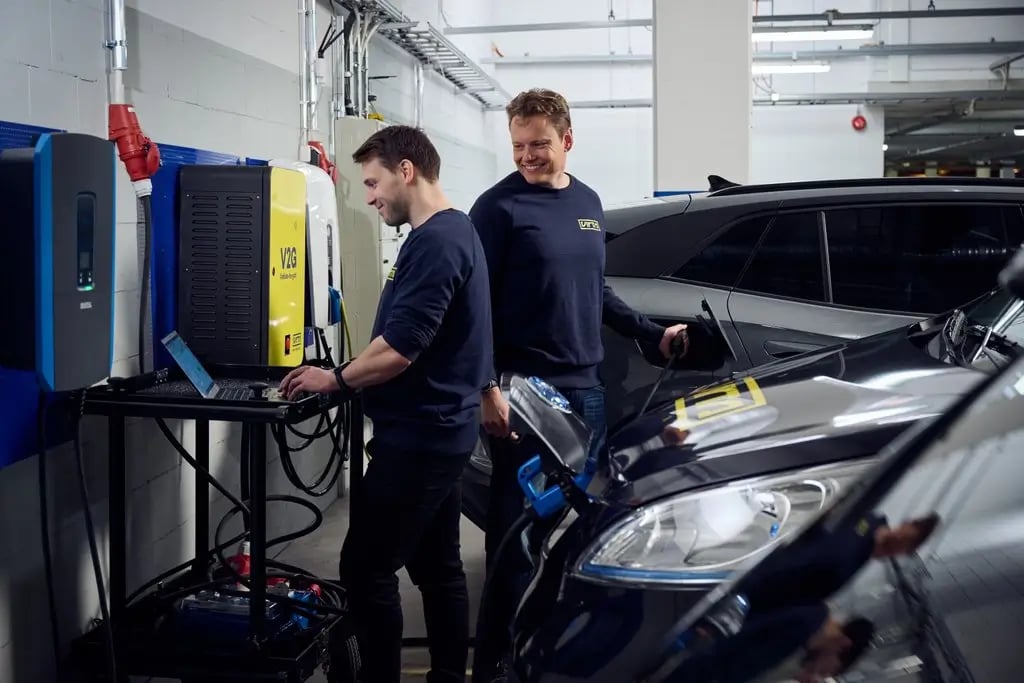
Photo illustrating two colleagues at Virta working with a V2G charger in a parking garage. Photo/Credits by Ville Vappula.
How does V2G work?
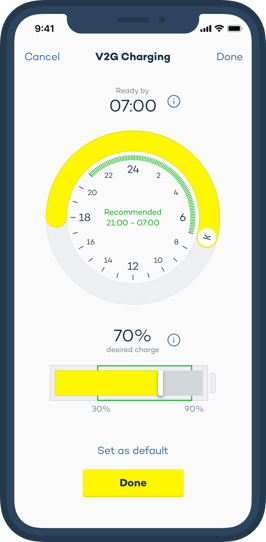
When it comes to using V2G in practice, the most important thing is to make sure that EV drivers have enough energy in their car batteries when they need it. For example, a driver must be able to make a trip to work and back, at any time.
This is the basic requirement of V2G and any other charging technology: The EV driver must be able to communicate when they want to unplug the car and how full the battery should be at that time.
With Virta’s V2G solution, the car battery is always charged to 70-90% when the driver needs to go.
When using smart charging, the possibility of balancing the grid ends when the battery is fully charged. With V2G, the grid balancing can continue the full time the vehicle is plugged in.
Private charging (at home or at work) is ideal for V2G as the time the vehicle is connected to the charger is long. This makes it possible to control the charging and discharging during the most suitable times for the electrical system.
How does electricity move?
First things first; let’s go through the very basics of how electricity behaves in the grid — it always takes the shortest possible way to the nearest location where it’s needed. A vehicle-to-grid charging device absorbs electricity from the car battery and simply just pushes it back to the grid, where it continues its journey to the nearest location where it’s needed.
A practical example: At the Virta HQ
At Virta HQ, we currently have seven V2G charging stations in use. These stations are located in the office building garage, next to regular, publicly available smart charging stations.
When the V2G station is discharging, the electricity here at Virta HQ transfers directly to the nearby car batteries charging at the regular stations — they are the nearest locations where the electrical demand is continuous.
If no cars are being charged, the discharged electricity will be used on garage lighting or air conditioning. This reduces the total energy consumption of the building, which balances the energy system around our office.
Let us take you on a virtual tour at Virta HQ to test our V2G charging solution:
...and at our customer's premises
Another example of V2G deployment is the eFuture project where Virta enabled Nissan to kickstart vehicle-to-grid (V2G) EV charging together with E.ON.
We provided a digital EV charging platform for E.ON that automates charging and energy export in line with signals such as grid demand, energy prices, and the carbon intensity of the energy mix, to test the effectiveness of V2G on a larger scale, in real conditions, with 20 V2G chargers.
The aim of this project, which started in the UK in 2020, was to demonstrate that V2G is a viable, sustainable and profitable solution for businesses.
During the project, vehicles were connected to the V2G chargers at intervals designed to replicate corporate fleet schedules – mainly overnight, but also for chunks of time during the day.
The benefits of Vehicle-to-Grid
Summary of the benefits depending on your targets:
- Reduce total cost of ownership (TCO) of fleets
- Car OEMs (manufacturers) can sell vehicles with added value
- Energy market parties can trade and optimise their balance
- Network operators can optimise investments & stabilise the grid
For real estate
When installing a charging station, step number one is to review the electrical system of the building. The electrical connection can become a hindrance to the EV charging installation project or increase costs significantly in case the connection needs to be upgraded.
Vehicle-to-grid, as well as other smart energy management features like Dynamic Load Management (DLM), help enable EVs to charge anywhere, regardless of the surroundings, location, or premise.
The benefits of V2G for buildings are visible when the electricity from car batteries is used where it is needed the most (as described in the previous chapter). Vehicle-to-grid helps balance out electricity demand and avoid any unnecessary costs for expanding the electricity system.
With V2G, the momentary electricity consumption spikes in the building can be balanced with the help of EVs and no extra energy needs to be consumed from the grid.
For the power grid
When power consumption increases, it can overload the power grid in the area. A building’s ability to balance its electricity demand with V2G charging stations also helps out the power grid on a larger scale.
This will come in handy when the amount of renewable energy in the grid, produced with wind and solar, increases. Renewable energy sources are volatile and create challenges in areas that rely on wind and solar power.
These circumstances cause “grid congestion” or bottlenecks that can prevent electricity from reaching its destination. Luckily, smartly controlled EVs can offer a solution to grid congestion and prevent the need for expensive grid infrastructure upgrades.
Without vehicle-to-grid technology, energy has to be bought from reserve power plants, which increases electricity prices during peak hours, since striking up these extra power plants is a pricey procedure. Plus majority of these reserve power plants produce carbon energy.
Without control, you need to accept this given price but with V2G you can optimise your costs and profits. In other words, V2G enables energy companies to play ping pong with electricity in the grid.
For fleets
Fleet operators can enroll into a V2G program and generate extra revenue as utilities will pay fleets for discharging their car's batteries. At the same time, your fleet can help balance the energy grid.
With vehicle-to-grid, fleets can use their vehicles as temporary energy storages. This can be especially helpful if your business relies mainly on building operations. In case of a lack of power or even a power outage, energy can be stored in your vehicles and discharged into your business's building whenever necessary.
For EV drivers
Why would individual EV drivers take part in vehicle-to-grid as a demand response then? As we explained earlier, it does no harm to them, but does it any good either?
Since vehicle-to-grid solutions are expected to become a financially beneficial feature for energy companies, they have a clear incentive to encourage consumers to take part.
After all, the technology, devices, and vehicles compatible with the V2G technology are not enough – consumers need to take part, plug in and enable their car batteries to be used for V2G.
Similarly to fleets, individual EV drivers can also benefit from extra earnings for storing excess energy in their vehicles and selling it back to electricity networks.
How will vehicle-to-grid become mainstream?
We're soon about to see V2G solutions commercially available. But there is a lot of development to be done before this technology becomes the mainstream energy management tool.
A. V2G technology and devices
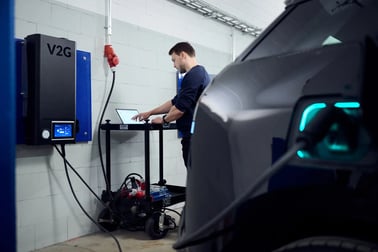
Multiple hardware providers have developed device models compatible with vehicle-to-grid technology. Just like any other charging devices, V2G chargers already come in many shapes and sizes.
Usually, the maximum charging power is around 11 kW — just enough for home or workplace charging. But we can also find V2G chargers with charging power up to 15 kW. In the future, even wider charging solutions will apply.
Vehicle-to-grid charging devices are DC (direct current) chargers, since this way the cars' own unidirectional on-board chargers can be bypassed. There have also been projects where a vehicle has an onboard DC charger and the vehicle can be plugged into an AC charger. However, this is not a common solution today.
To wrap up, devices exist and are feasible, yet there's still room for improvement as the technology matures.
B. V2G compatible vehicles
Currently, CHAdeMo electric vehicle OEMs, such as Nissan, have outpaced other car manufacturers by bringing V2G compatible car models to the market. All Nissan Leafs and Nissan e-NV200 can be discharged with vehicle-to-grid stations. Mitsubishi also joined the club with its Outlander PHEV and iMiev models, which are now also V2G compatible.
Some other car models with V2G capabilities are Peugeot iON and Citroën C0.
The ability to support V2G is a real opportunity for OEMs and many more of them will hopefully join the club of vehicle-to-grid compatibles soon.
For example, Ford is planning to commercialise V2G with their F-150 Lightning electric pickup truck and Hyundai with their IONIQ 5 model while Volkswagen is also implementing the ISO-15118 standard in their vehicles.
Compatibility with the CCS standard is planned to become commercialised by 2025.
Does V2G affect car battery life?
C. Cooperation: Car manufacturers and the energy sector must step in
Vehicle-to-grid is only one (but very impactful) example of the energy management possibilities that EVs offer us for the future. The thing is that energy and mobility sectors will converge in the future, with or without V2G. We believe that it is with.
However, big wheels turn slowly, and there is some resistance to change. Nissan is showing a great example to other car manufacturers to start cooperating with the energy sector in order to develop something new and life-changing and to look boldly into the future. The car industry is going through a revolution like never before. Combining forces with the energy sector offers the car industry a chance to begin a new heyday.
The same goes for the energy sector: As energy efficiency increases and more renewables step in, the ongoing change will be drastic for the electrical grid. The energy sector must find new ways to balance energy production and consumption. Luckily, EVs are ready to lend a hand.
D. European standards that make EV charging easier
The demand response markets in Europe are growing at over 20% growth rate. V2G is one of the most promising tools in the demand response markets. No wonder that the V2G market is projected to grow to over $5 billion by 2024.
At the moment, the V2G is still a project-based business, but this is all about to change. V2G will soon become a commercially profitable business, and there will be more and more V2G companies surfacing.
The European ISO 15118-20 standard defines a vehicle-to-grid communication interface for bi-directional charging and enables bi-directional power transfer for multiple cars.
In practice, with standards like these, EV charging becomes smarter, more efficient and more convenient. This means that EV battery capacity for energy management will grow heavily in the next couple of years.
Once-in-a-lifetime opportunity
The first V2G projects are running, and vehicle-to-grid solutions are being implemented. V2G will become a vital solution first in locations where the energy system is the most volatile.
The most important thing, despite the location, is that the installed charging devices are smart – otherwise, all of the smart energy management features will be inaccessible.
As soon as the V2G technology becomes the norm, EVs will also be able to support the grid in a state of emergency. If extreme weather conditions cause power outages, electric vehicles can maintain power for basic needs until the problem is fixed. This will make the electricity system less vulnerable and less dependent on external conditions.
Now we just need all the players to start making the most of the largest and most cost-efficient energy storage that we have – electric vehicles.
From our blog
Stay up to date with what is new in our industry, learn more about the upcoming products and events.
/woman-charging-ev-wind-turbine-blue-background.webp?width=1920&height=1080&name=woman-charging-ev-wind-turbine-blue-background.webp)
What is smart charging, and why do our energy systems need it?
/vertical-solar-panels-modern-design.webp?width=1920&height=1080&name=vertical-solar-panels-modern-design.webp)
